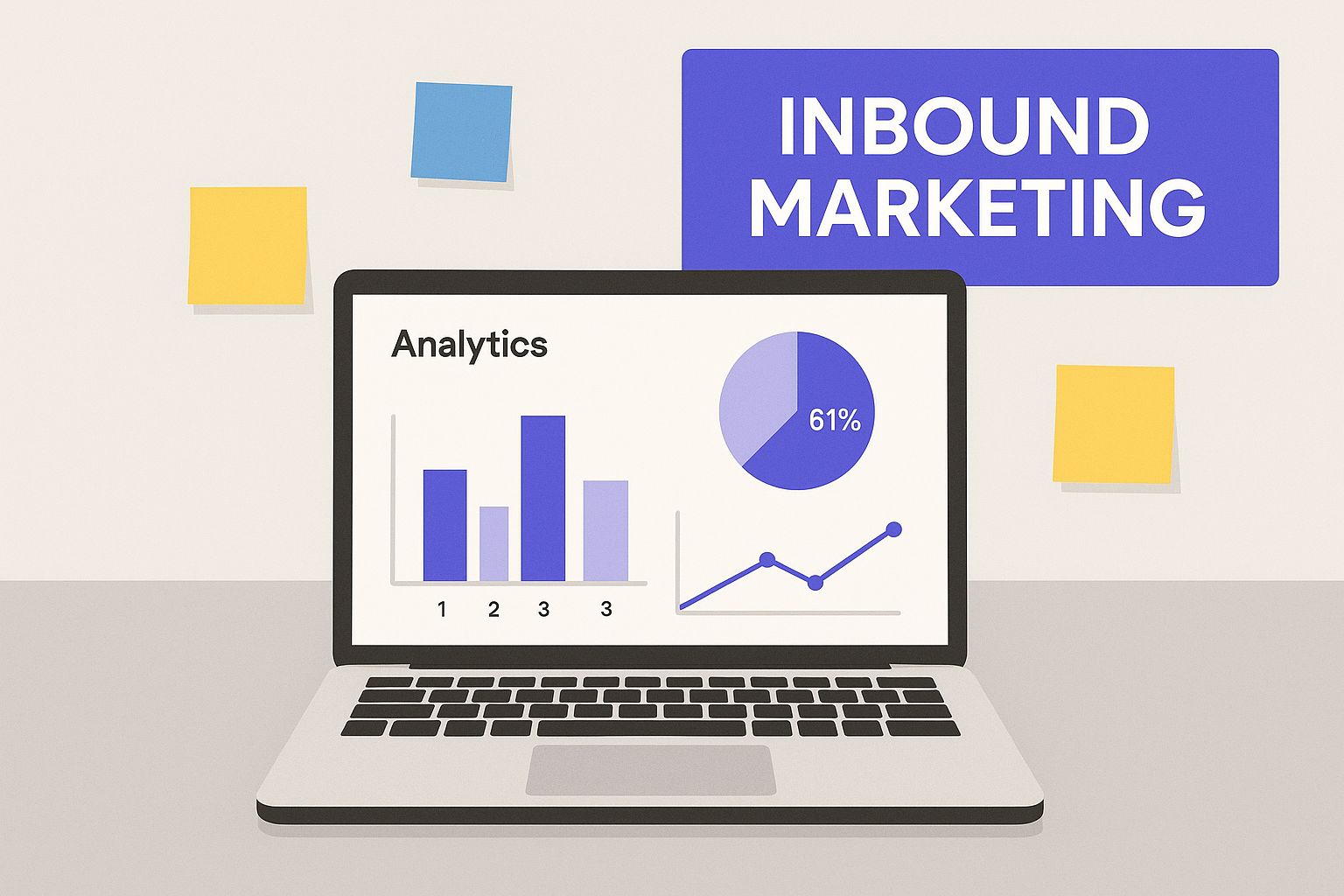Discover what is inbound outbound marketing. This guide explains the core differences, key benefits, and how to combine them for explosive business growth.
Let's cut right to the chase. You're hearing "inbound" and "outbound," and you need to know which one will actually grow your business. The core difference boils down to a single question: are you pulling customers in or pushing your message out?
Think of inbound marketing as a magnet. It’s about creating valuable content—like expert guides, data-driven reports, or helpful tools—that naturally draws prospects to you right when they are searching for a solution to their problem. You're earning their attention.
Outbound marketing is more like a spear. It’s a direct, targeted effort to reach specific individuals you’ve already identified as ideal customers. You aren't waiting for them to find you; you're initiating the conversation.
The Magnet vs. The Spear: A Quick Comparison
Feeling the pressure to generate pipeline? When you're frantically Googling for answers, reading blog posts, or checking product reviews, you're experiencing an inbound strategy. A company created something so helpful that you found it on your own terms.
On the flip side, that hyper-targeted LinkedIn ad in your feed or the direct email from a sales rep trying to book a demo? That’s outbound. The company took the first step, believing you fit their ideal customer profile.
To really nail down what is inbound outbound, you need to see the two approaches side-by-side. The fundamental difference is who starts the conversation.
Ready for a no-fluff breakdown? Here’s how these two strategies compare.
Inbound vs Outbound Marketing At a Glance
| Attribute | Inbound Marketing (The Magnet) | Outbound Marketing (The Spear) |
|---|---|---|
| Initiator | Customer initiates contact | Seller initiates contact |
| Approach | Pull: Attracts with value | Push: Interrupts with a message |
| Communication | Two-way, conversational | One-way, direct pitch |
| Targeting | Broad audience, self-qualifying | Specific, pre-defined list |
| Key Assets | SEO, blogs, content, social media | Email lists, ad platforms, sales reps |
| Goal | Build trust and authority | Generate immediate response/leads |
| ROI Timeline | Long-term, compounding | Short-term, campaign-based |
Neither approach is inherently "better"—they are different tools for different jobs, and the best revenue teams know how to use both.
This infographic breaks down how modern inbound marketing really works, using data and analytics to create a continuous loop of attraction and engagement.

Image
As you can see, the goal is to build a valuable digital presence that your ideal customers discover organically. It’s a long-term play that builds incredible trust and authority.
For your B2B SaaS or fintech company, this distinction is absolutely critical. Your sales cycle length, average contract value, and target audience dictate the right mix. A long, complex sales process for a high-ticket item thrives on the trust-building nature of inbound. But if you need to reach five specific decision-makers at an enterprise account, the precision of an outbound spear is required.
As data from HubSpot consistently shows, companies that align their GTM strategies with the buyer's journey see far better results. The most successful revenue engines don't choose one over the other—they masterfully integrate both into a single, powerful go-to-market motion. Let's explore exactly how you can do that next.
How Inbound Marketing Pulls in Your Ideal Customer
Inbound marketing works on a simple, powerful idea: earn attention, don’t buy it. Forget interrupting potential customers with ads they don't want to see. Your goal is to become such a valuable resource that they actively seek you out.
Think of it like leaving a trail of helpful, insightful breadcrumbs—blog posts, templates, webinars—that lead your ideal customer directly to your solution. It’s not about a hard sell; it’s about solving their problems and building trust long before a sales conversation ever happens. This is why inbound leads cost 61% less on average than outbound leads, according to HubSpot research. It’s just more efficient.

Image
The Pillars of a Solid Inbound Strategy
A powerful inbound engine doesn't just happen. It’s built on a few key pillars that work together to attract, engage, and ultimately win over your target audience.
- •Search Engine Optimization (SEO): This is how you get found. When a prospect Googles a problem you solve, SEO ensures your content appears at the top of the results, ready to help.
- •Content Marketing: This is the actual value you provide. It’s the meat of your strategy—the in-depth guides, free tools, and expert articles that address your audience's biggest pain points. For example, instead of just saying "we help with finance," you create a downloadable financial modeling template.
- •Social Media Marketing: This is where you build a community. You share your content, join relevant conversations, and turn passive followers into genuine fans of your brand.
For a real-world example, picture a B2B SaaS company that offers a free, downloadable "Churn Prediction Calculator." They aren't just giving away a tool. They're strategically attracting VPs of Customer Success, demonstrating their expertise, and converting anonymous website visitors into highly qualified leads for their paid platform.
"The best marketing doesn't feel like marketing." – Tom Fishburne, Founder of Marketoonist
This is the heart of the inbound philosophy. The entire focus shifts from self-promotion to genuine education and empowerment. It’s about making your business a destination.
Interestingly, this magnetic approach isn't just for digital marketing. Look at the travel industry. Inbound tourism to the Middle East is projected to grow at an annual rate of 13% from 2025 to 2030, simply because the region has become a more attractive destination. You can dig into these travel trends in the Arabian Travel Market's 2025 report. The principle is the same: create something valuable and compelling, and people will come to you.
Why Outbound Marketing Still Drives Growth
Let's get one thing straight: the old image of aggressive cold calls and spammy email blasts is dead. Modern outbound marketing isn't a blunt instrument; it's a high-precision tool for starting valuable conversations with high-value prospects who don’t even know you exist yet.
This approach puts you firmly in the driver's seat. Instead of waiting for the right leads to stumble upon your content, you proactively identify the best-fit accounts and engage them directly. This level of control is exactly why 60% of marketers still see outbound strategies as a highly effective way to generate quality leads, according to a recent marketing survey. You get to target specific decision-makers and seriously speed up your sales cycle.

Image
Modern Tactics for Direct Engagement
Today's outbound isn't about casting a wide, impersonal net. It’s about surgical precision. It's about delivering relevance at scale to open doors that your inbound efforts might never find.
Effective modern outbound is built on tactics like these:
- •Targeted Email Outreach: This isn't a mass blast. It’s crafting personalized messages that speak directly to the pain points of a highly curated list of prospects. For example, referencing a specific company announcement in your outreach to show you've done your homework.
- •Account-Based Marketing (ABM): Here, you treat an entire target company as a market of one. Sales and marketing efforts are tightly coordinated to engage key stakeholders across the organization, from the manager level to the C-suite.
- •Laser-Focused Digital Advertising: Platforms like LinkedIn are perfect for running campaigns that reach professionals based on their exact job title, industry, or company size.
Think about it this way: a B2B fintech company could run a LinkedIn ad campaign that targets only CFOs at private equity firms with over $500M AUM. That’s not spam; it’s a direct, highly relevant conversation starter.
Opening Doors and Accelerating Growth
The real power of outbound lies in its ability to build a predictable pipeline and penetrate specific market segments—fast. While inbound is fantastic for building long-term authority, outbound delivers immediate market feedback and crucial short-term wins.
This proactive approach is mirrored in other industries, too. For example, outbound visitor numbers from the Middle East shot up by a staggering 28.1% in 2023, right after an even bigger jump the year before. This data shows a powerful, proactive movement toward specific destinations, driven by clear intent. You can dig into the Middle East outbound trends on Statista to see the full picture.
Just as travelers proactively choose where they want to go, a smart outbound strategy lets you choose your next customer. It’s about creating opportunities, not just waiting for them to knock.
Inbound vs. Outbound: Which Strategy is Right for You? (Hint: It’s a Trick Question)
The endless "inbound vs. outbound" debate completely misses the mark. There’s no universal winner. The right approach depends entirely on your business model, your Ideal Customer Profile (ICP), how long it takes to close a deal, and of course, your budget.
A direct-to-consumer brand can absolutely explode using inbound SEO and a clever social media game. But an enterprise fintech company selling a complex, six-figure solution to a handful of CFOs? They won’t get a foot in the door without a hyper-precise outbound strategy. The approach has to fit the market.
It’s Not a Choice; It’s a Blend
For almost every B2B company trying to scale, the answer isn’t picking one. The most durable, predictable growth engines are built on a hybrid model that combines the strengths of both inbound and outbound. When you integrate them correctly, each strategy makes the other one stronger.
The most resilient businesses don't choose one or the other—they build a hybrid model. This creates a powerful growth engine where inbound generates consistent lead flow and outbound accelerates growth by targeting high-value accounts.
Think of it this way: your inbound machine (content, SEO, webinars) is like casting a wide fishing net. It consistently brings in a steady catch of qualified leads who are already looking for a solution like yours.
At the same time, your outbound team acts as spearfishers. They’re not waiting for the fish to come to them; they’re actively hunting the specific, high-value accounts you need to land to crush your revenue targets.
This hybrid approach is the only way to build a truly predictable revenue machine. Getting these two functions to work together is a huge challenge, but our guide on improving sales and marketing alignment gives you a clear framework to make it happen.
This interplay between attracting and seeking isn't just a business concept; it mirrors how economies work. For example, in 2023, tourism drove an estimated 6.7% of the Middle East’s GDP, with the region actually beating pre-pandemic arrival numbers. As the World Bank's analysis of MENA tourism shows, this recovery relied on both the inbound pull of attractions and the outbound promotion of travel. Just like a national economy, your business needs to find its own strategic balance to thrive.
Building a Powerful Hybrid Marketing Model
Theory is one thing, but building a predictable revenue engine is all about action. The real goal isn't to pit inbound against outbound in some kind of strategic deathmatch. It's to weave them together into a single, cohesive system where each one makes the other stronger.
When you get this right, you create a powerful flywheel effect. Think about it: your outbound sales team is on the front lines, hearing priceless intel on customer objections and pain points every single day. That raw feedback is pure gold—it should directly dictate the topic of your next inbound blog post or webinar, ensuring your content hits exactly what the market cares about.
Creating a Feedback Loop for Growth
Then, when that perfectly targeted inbound content attracts a warm, qualified lead, the process flips. Instead of letting that lead go cold waiting for them to take the next step, you can immediately route them to a sales rep for a personalized, high-touch outbound follow-up. This synergy transforms two separate tactics into a unified growth machine.
This isn’t just about passing leads back and forth. It’s about building a system where data and insights flow seamlessly between marketing and sales, constantly sharpening your entire go-to-market motion.
According to a report from Salesforce, sales teams that actively collaborate with marketing see a 208% higher marketing contribution to their pipeline. Integrating inbound and outbound is the most direct way to make that collaboration a reality.
A Simple Framework for Integration
Getting started doesn't mean you have to overhaul your entire operation overnight. You can start building this synergy with a simple, three-step framework that connects your activities.
- •Map the Handover Points: Get crystal clear on the exact criteria for when an inbound lead (MQL) is ready for outbound sales engagement (SQL). What specific actions must they take—like viewing your pricing page three times in a week—to signal they're ready for a conversation?
- •Establish an Intel Channel: Create a dedicated, recurring process for the sales team to feed customer language, objections, and burning questions back to the marketing team. Make it a weekly ritual in a shared Slack channel or a recurring 30-minute meeting.
- •Align Campaigns: Coordinate your efforts. If your outbound team is targeting CFOs in the fintech space, your inbound content should simultaneously be addressing the specific challenges and pressures those CFOs are facing, using titles like "The CFO's Guide to Navigating Q4 Headcount Planning."
Building this hybrid model is a core function of a high-performing revenue engine. If you're looking to implement this kind of alignment, our complete guide to Revenue Operations provides a detailed blueprint for B2B SaaS companies.
Common Questions About Inbound and Outbound
When you start blending inbound and outbound, the theory is great, but the practical questions always pop up. Getting the details right is what turns a good strategy into a predictable revenue engine. Let's tackle some of the most common hurdles we see founders and RevOps leaders face.
Which Strategy Has a Better ROI?
This is the million-dollar question, and the answer depends entirely on your timeline. Inbound almost always delivers a superior long-term ROI because your content becomes a compounding asset, generating leads for years to come. In fact, HubSpot data shows inbound leads can cost 61% less than outbound leads.
But here's the catch: inbound takes time. Outbound, on the other hand, can deliver faster, more predictable results in the short term, which is crucial for hitting those quarterly targets. The smartest approach isn't choosing one over the other; it’s about balancing both for immediate pipeline impact and sustainable, long-term growth.
Can a Small Business Realistically Do Both?
Absolutely. You don’t need a massive team or a venture-sized budget, just a laser-focused approach. The biggest mistake we see is trying to do everything at once. Don't.
Instead, start small and prove the model with one core channel for each strategy:
- •Inbound: Forget a 10-category blog. Start by obsessively solving one specific problem for your niche audience and become the go-to resource for it.
- •Outbound: Don't buy a list of 10,000 names. Build a curated list of your 50 absolute dream customers and create a highly personalized email outreach campaign.
Once you prove what works, you can strategically scale your efforts from there. The key is to master one or two channels before you even think about expanding.
How Do You Measure Success for Each Strategy?
This is where so many companies get it wrong. The success metrics for inbound and outbound are fundamentally different, and if you don't track them correctly, you'll end up killing initiatives that are actually working.
For inbound, you're playing the long game. Focus on leading indicators of brand gravity and audience building:
- •Organic website traffic and keyword rankings
- •Content conversion rates (e.g., a 4% download rate on a new checklist)
- •The volume and quality of your marketing-qualified leads (MQLs)
For outbound, your KPIs are much more direct and tied to immediate sales activity:
- •Email open and, more importantly, reply rates (aiming for a 10%+ reply rate is a strong benchmark).
- •The raw number of qualified meetings booked.
- •Sales cycle velocity and close rates.
Ultimately, both sets of metrics must tie back to revenue. Understanding how each activity truly contributes to the bottom line is non-negotiable, which is why having the right attribution in place is so critical. You can see exactly how this looks in our detailed attribution model case study.
Altior Team
RevOps Specialists
Helping B2B SaaS companies build predictable revenue engines through strategic RevOps implementation.

